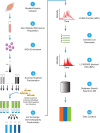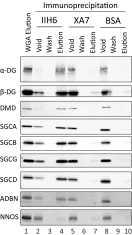Molecular Signatures of Membrane Protein Complexes Underlying Muscular Dystrophy
- PMID: 27099343
- PMCID: PMC5083101
- DOI: 10.1074/mcp.M116.059188
Molecular Signatures of Membrane Protein Complexes Underlying Muscular Dystrophy
Abstract
Mutations in genes encoding components of the sarcolemmal dystrophin-glycoprotein complex (DGC) are responsible for a large number of muscular dystrophies. As such, molecular dissection of the DGC is expected to both reveal pathological mechanisms, and provides a biological framework for validating new DGC components. Establishment of the molecular composition of plasma-membrane protein complexes has been hampered by a lack of suitable biochemical approaches. Here we present an analytical workflow based upon the principles of protein correlation profiling that has enabled us to model the molecular composition of the DGC in mouse skeletal muscle. We also report our analysis of protein complexes in mice harboring mutations in DGC components. Bioinformatic analyses suggested that cell-adhesion pathways were under the transcriptional control of NFκB in DGC mutant mice, which is a finding that is supported by previous studies that showed NFκB-regulated pathways underlie the pathophysiology of DGC-related muscular dystrophies. Moreover, the bioinformatic analyses suggested that inflammatory and compensatory mechanisms were activated in skeletal muscle of DGC mutant mice. Additionally, this proteomic study provides a molecular framework to refine our understanding of the DGC, identification of protein biomarkers of neuromuscular disease, and pharmacological interrogation of the DGC in adult skeletal muscle https://www.mda.org/disease/congenital-muscular-dystrophy/research.
© 2016 by The American Society for Biochemistry and Molecular Biology, Inc.
Figures









Similar articles
-
Signaling through the dystrophin glycoprotein complex affects the stress-dependent transcriptome in Drosophila.Dis Model Mech. 2023 Jan 1;16(1):dmm049862. doi: 10.1242/dmm.049862. Epub 2023 Jan 31. Dis Model Mech. 2023. PMID: 36594281 Free PMC article.
-
Proteomics of the dystrophin-glycoprotein complex and dystrophinopathy.Curr Protein Pept Sci. 2013 Dec;14(8):680-97. doi: 10.2174/13892037113146660083. Curr Protein Pept Sci. 2013. PMID: 24106963 Review.
-
[Muscular dystrophies with dystrophin glycoprotein complex deficit].Neurol Neurochir Pol. 1999 Nov-Dec;33(6):1381-9. Neurol Neurochir Pol. 1999. PMID: 10791040 Review. Polish.
-
Value of muscle magnetic resonance imaging in the differential diagnosis of muscular dystrophies related to the dystrophin-glycoprotein complex.Orphanet J Rare Dis. 2019 Nov 12;14(1):250. doi: 10.1186/s13023-019-1242-y. Orphanet J Rare Dis. 2019. PMID: 31747956 Free PMC article.
-
The dystrophin-glycoprotein complex, cellular signaling, and the regulation of cell survival in the muscular dystrophies.Muscle Nerve. 2001 Dec;24(12):1575-94. doi: 10.1002/mus.1192. Muscle Nerve. 2001. PMID: 11745966 Review.
Cited by
-
How Can Proteomics Help to Elucidate the Pathophysiological Crosstalk in Muscular Dystrophy and Associated Multi-System Dysfunction?Proteomes. 2024 Jan 16;12(1):4. doi: 10.3390/proteomes12010004. Proteomes. 2024. PMID: 38250815 Free PMC article.
-
Proteomic profiling of the dystrophin complex and membrane fraction from dystrophic mdx muscle reveals decreases in the cytolinker desmoglein and increases in the extracellular matrix stabilizers biglycan and fibronectin.J Muscle Res Cell Motil. 2017 Apr;38(2):251-268. doi: 10.1007/s10974-017-9478-4. Epub 2017 Aug 12. J Muscle Res Cell Motil. 2017. PMID: 28803268
-
The Dystrophin Node as Integrator of Cytoskeletal Organization, Lateral Force Transmission, Fiber Stability and Cellular Signaling in Skeletal Muscle.Proteomes. 2021 Feb 2;9(1):9. doi: 10.3390/proteomes9010009. Proteomes. 2021. PMID: 33540575 Free PMC article. Review.
-
Comparative gel-based proteomic analysis of chemically crosslinked complexes in dystrophic skeletal muscle.Electrophoresis. 2018 Apr 20;39(14):1735-44. doi: 10.1002/elps.201800028. Online ahead of print. Electrophoresis. 2018. PMID: 29679381 Free PMC article.
-
Histopathology of Duchenne muscular dystrophy in correlation with changes in proteomic biomarkers.Histol Histopathol. 2022 Feb;37(2):101-116. doi: 10.14670/HH-18-403. Epub 2021 Dec 7. Histol Histopathol. 2022. PMID: 34873679 Review.
References
-
- Mokri B., and Engel A. G. (1975) Duchenne dystrophy: electron microscopic findings pointing to a basic or early abnormality in the plasma membrane of the muscle fiber. Neurology 25, 1111–1120 - PubMed
-
- Ibraghimov-Beskrovnaya O., Ervasti J. M., Leveille C. J., Slaughter C. A., Sernett S. W., and Campbell K. P. (1992) Primary structure of dystrophin-associated glycoproteins linking dystrophin to the extracellular matrix. Nature 355, 696–702 - PubMed
-
- Hohenester E., Tisi D., Talts J. F., and Timpl R. (1999) The crystal structure of a laminin G-like module reveals the molecular basis of alpha-dystroglycan binding to laminins, perlecan, and agrin. Mol. Cell 4, 783–792 - PubMed
-
- Campbell K. P., and Kahl S. D. (1989) Association of dystrophin and an integral membrane glycoprotein. Nature 338, 259–262 - PubMed
-
- Ozawa E., Yoshida M., Suzuki A., Mizuno Y., Hagiwara Y., and Noguchi S. (1995) Dystrophin-associated proteins in muscular dystrophy. Human Mol. Genetics 4, 1711–1716 - PubMed
Publication types
MeSH terms
Substances
Grants and funding
LinkOut - more resources
Full Text Sources
Other Literature Sources
Medical
Research Materials

